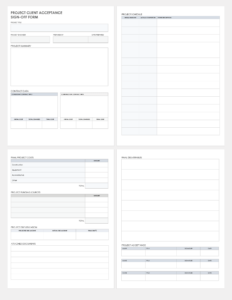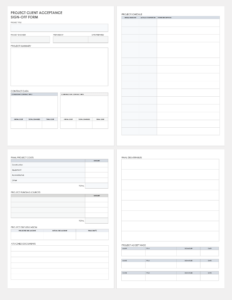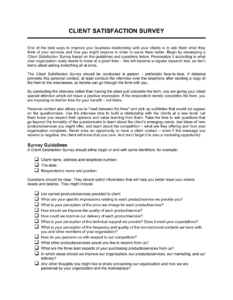Ever found yourself at the end of a project, thinking everything’s wrapped up, only to have a client or stakeholder pop up with last-minute changes or questions about something they thought was included? It’s a common scenario, and frankly, it can be quite frustrating and costly. This is precisely where a well-structured project sign off document template becomes your best friend. It’s not just a formality; it’s a critical tool that formalizes the acceptance of project deliverables, ensuring everyone is on the same page and acknowledges that the work is complete according to the agreed-upon scope.
Think of it as the project’s official handshake, a clear demarcation line that marks the transition from active development to completion. It provides a formal record of acceptance, protects both your team and the client, and minimizes potential disputes down the line. Without this crucial step, projects can linger indefinitely, and misunderstandings can quickly escalate. Let’s dive deeper into what makes these templates so indispensable for any project manager or team.
What Essential Elements Make a Project Sign Off Document Template Effective?
When you’re preparing to finalize a project, the sign-off document isn’t just a blank piece of paper waiting for a signature. It’s a carefully crafted agreement that captures all the critical details of what was delivered and what was accepted. An effective project sign off document template acts as a comprehensive checklist and a formal record, ensuring no stone is left unturned and all parties fully understand what they are agreeing to. It brings clarity to the often-muddy waters of project completion.
First and foremost, it needs to clearly identify the project itself. This might seem obvious, but including the project name, ID, and relevant dates ensures there’s no confusion about which specific piece of work is being signed off. Following this, a detailed summary of the deliverables being accepted is crucial. This isn’t just a vague statement; it should list the specific items, features, or outcomes that have been completed and are now being handed over. This level of specificity helps prevent any post-sign-off claims of missing components.
Beyond the deliverables, the template should include a section for acceptance criteria. These are the standards or conditions that the deliverables needed to meet to be considered complete and satisfactory. Did the website need to load within 3 seconds? Was the software required to pass all user acceptance tests? Documenting these criteria and confirming they’ve been met provides objective proof of completion. Finally, and perhaps most critically, there must be dedicated spaces for all relevant stakeholders to formally sign and date the document, acknowledging their agreement. This includes clients, project managers, and any other key decision-makers.
To ensure your document is truly robust and covers all bases, consider including these key sections:
Essential Sections You Can’t Miss
-
Project Identification: Clear naming, version numbers, and relevant dates.
-
Scope and Deliverables: A detailed list of all completed work and outcomes.
-
Acceptance Criteria: Specific metrics or conditions met by the deliverables.
-
Outstanding Items or Next Steps: Any remaining tasks, future phases, or follow-ups.
-
Stakeholder Acceptance: Dedicated signature blocks for all approving parties with their roles and dates.
-
Disclaimers or Limitations: Any specific conditions or limitations on the acceptance.
By meticulously filling out each of these sections, your project sign off document template transforms from a mere formality into a powerful tool for project governance and successful closure.
The Undeniable Advantages of Implementing a Standard Project Sign Off Document Template
Adopting a standardized project sign off document template isn’t just about ticking a box; it’s about strategically safeguarding your projects and fostering stronger relationships. The benefits extend far beyond simply getting a signature. One of the most significant advantages is the absolute clarity it brings to the project’s conclusion. It forces all parties to review the work, compare it against the initial scope, and collectively agree that the project objectives have been met. This structured review process inherently reduces ambiguity and minimizes the chances of misinterpretation or forgotten requirements.
Moreover, these templates are invaluable for risk mitigation. Without a formal sign-off, a client could potentially claim that a project was never truly completed or that certain aspects were not delivered as expected, even months after the fact. A signed document provides concrete evidence of acceptance, offering legal protection and a clear audit trail should any disputes arise. It draws a definitive line under the project, protecting your team from endless revisions or scope creep after the agreed-upon completion date.
Another critical benefit is improved communication and accountability. The process of signing off encourages open dialogue about the delivered work. It’s an opportunity for stakeholders to voice any final concerns or confirm their satisfaction. For project teams, it instills a sense of accountability, knowing that their work will eventually undergo a formal review and require official acceptance. This can motivate teams to deliver high-quality work right from the start, aiming for that smooth final sign-off.
Consider these compelling reasons why integrating a project sign off document template into your workflow is a game-changer:
-
Minimizes Scope Creep: Clearly defines the end of the project scope, preventing requests for additional work without proper change orders.
-
Ensures Clarity for All Parties: Provides a shared understanding of what has been delivered and accepted.
-
Provides Legal and Audit Trail: Serves as concrete evidence of project completion and client acceptance for future reference or legal needs.
-
Boosts Team Accountability: Encourages teams to deliver complete and high-quality work, knowing it will be formally reviewed.
-
Facilitates Smooth Project Closure: Streamlines the transition from project execution to operational handover or final billing.
-
Enhances Professionalism: Demonstrates a structured, organized approach to project management, building client trust.
Ultimately, a robust sign-off template helps you close projects confidently, ensuring that both your team and your clients are satisfied with the outcome and ready to move forward.
Implementing a dedicated template for project sign-offs might seem like an extra step, but its long-term value is immense. It transforms what can often be a murky and contentious process into a clear, professional, and mutually agreeable conclusion. By formalizing acceptance, you protect your resources, maintain clear communication, and lay the groundwork for future successful collaborations. It’s about ensuring that when a project concludes, everyone involved can confidently say, “Yes, we’re done.”
Embracing this simple yet powerful tool will streamline your project management processes, prevent common headaches, and significantly enhance client satisfaction. It’s an investment in clarity and peace of mind, making sure every project ends not with a whimper, but with a clear, resounding affirmation of completion.


